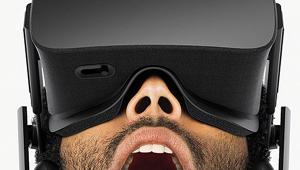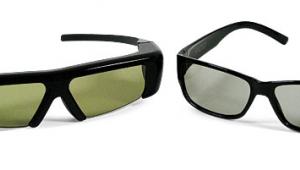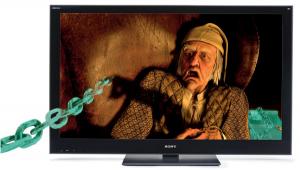I wouldn't touch this "re-thread" of 1950's technology even if you paid me to do so, not with the need to use shutter glasses, active or passive. I use contact lenses and find that often times i need to take them off and wear my eyeglasses for a more comfortable viewing experience, and i certainly don't see how it would be possible to wear 3-D glasses on top of eyeglasses !Never mind warnings for people with epilepsy, pregnant women, infants, people with eye problems, susceptible people, etc, etc... My understand is that Sony has already shown and promises to deliver within three to four years 3-D technology without the need for shutter glasses; May be by then, price permitting, i'll consider it.
Glasses—3D's Achilles' Heel

Aye, there's the rub—to see anything in 3D on that new TV, you must wear special glasses. In all the hoopla about 3D, this inconvenient truth is often glossed over, yet it's one of the biggest pitfalls in the entire 3D infrastructure.
Virtually all 3DTVs now coming to market use active-shutter glasses, in which the left and right lenses alternately open and close in sync with the TV, which displays the left-eye image when the left lens is open and the right-eye image when the right lens is open. By contrast, most commercial 3D theaters use passive glasses—the right and left images are projected simultaneously, and the glasses filter the light so that only the left image reaches the left eye and only the right image reaches the right eye.
Aside from consumers' disdain for having to wear glasses at all, there are a few other drawbacks that could seriously impede the adoption of 3D in the home. First, there's the expense—active-shutter glasses cost $100 to $150 per pair! In some cases, one or two pairs might be included with a new 3DTV, but what if you have a family of three, four, or more? What if you want to host a Super Bowl party? Are you going to spend hundreds of dollars for extra glasses after dropping several thousand on the TV?
Passive glasses are much less expensive, which is why they are used in public settings, but they have other drawbacks in the home. For example, with direct-view TVs such as LCD and plasma, using passive glasses cuts the horizontal or vertical resolution available for each eye in half. Can a resolution of 1920x540 or 960x1080 rightly be called high def?
Another problem with 3D glasses of all types is that they dramatically reduce the amount of light reaching your eyes. As it turns out, active-shutter glasses lose much more light than passive glasses because both lenses in active glasses must be closed during part of each cycle to prevent crosstalk (the left image getting into the right eye and vice versa). As a result, the display must pump out much more light than it does in 2D, which could shorten its life, especially plasmas. Even so, the perceived image is much dimmer than watching 2D.
Then there's the issue of cross-compatibility between manufacturers—or, more specifically, the lack thereof. That's right, the glasses for a Panasonic 3DTV won't work with a Samsung model and vice versa. Why? The TV emits an infrared signal that the glasses use to synchronize with the alternating images. You might think that the manufacturers would have agreed on a standardized IR signal to perform this function, but no—each company uses its own proprietary signal. How stupid is that? Really stupid if you ask me.
A company called XpanD is trying to address this issue with its X103 "universal" active-shutter glasses (shown above), which are scheduled to be available in June. The glasses will contain a database of different manufacturers' IR sync signals, sort of like universal remotes with a database of different manufacturers' remote IR codes.
Will the issues I've presented here slow the infiltration of 3D into the home? Perhaps not in the initial stages, when early adopters eagerly acquire anything new. But mainstream consumers might not want to don glasses just to watch TV, not to mention having to shell out hundreds of dollars on extra pairs for the whole family. (Of course, you can watch regular 2D content without glasses, but then why get a 3DTV?) And forget about taking your Sony glasses to a friend's house to watch their Toshiba 3DTV—they probably won't work.
What's your take on the whole glasses angle? Will the requirement to wear them dissuade you from buying into 3D? Perhaps you object to the high cost, dim image, or cross-manufacturer incompatibility. Or maybe none of this matters and you can't wait to jump into the third dimension. In any event, I look forward to reading your comments here.
- Log in or register to post comments

I would like to know why tv manufactures are only using active shutter glasses instead of the passive route. I do understand about the off angle issues that you mentioned above. Also, my local movie theater finally broke down and got a 3D projector which looks phenomenal. I peeked into the a/v room and seen that the projector was an NEC REAL-D3XL. Is this one of the standard state of the art DLP projectors? I was just curious how it compares to other theaters as far a picture quality goes.

One more thing Scott. Why have I not heard of any 3D consumer projectors yet? For myself, I will not buy a 3D panel until its at least 2 or 3 years into the tech cycle. Honestly though, my wife and I would like to wait a few years and get a 3D projector as long as they aren't a zillion dollars. I believe 3D at home would be much better with a front projector set-up.

From someone in the television broadcast industry, 3D is a fad. Sure content providers will supply material, but a very small percentage of viewers will purchase the sets. Heck, HDTV is still "new". DTV (digital television broadcast) is still new. Remember surround sound the the competing technologies? This is 3D now. Back to R & D for 3 & D.

Jarod, manufacturers are using active shutter glasses with flat panels because passive glasses limit the display to half resolution horizontally or vertically for each eye. I don't know the NEC projector specifically, but I don't doubt that it looks great. As for consumer 3D projectors, they are coming, though they have their own problems; for example, projectors that use polarization (which, I suspect, will be most if not all consumer models) require a special screen that might not be ideal for 2D viewing. I will cover 3D projectors in a future entry in this blog.

It is nice to watch "sometimes" with 3D. My 3y/o daughter enjoyed watching a demo. But I am not sure if she can tolerate it for 2 hours. Even my wife was fascinated with a demo from LG (passive glasses) but got some eye strain for 5 mins of watching. If the price of the glasses become reasonable, then people might be able to consider it. But for 100 dollars a piece, Wow! That is a lot of glasses for 1 family. And I agree that manufacturers should agree in cross compatibility. It just says one thing for them. Cashing in...

Scott - you mentioned that you can of course watch 2D content on a 3D tv, so why buy a 3D tv if you are not interested. Well, if you are interested in the best PQ you can get, most manufacturers top of the line sets include 3D anyway. I'm looking at buying a 53 to 55" set this year and have narrowed my choices down to the Sony HX900 and Vizio 55" PRO series set. Both include LED backlighting with local dimming and of course, 3D. The prices of the 3D sets seem reasonable, but the real downfall is in the price of the glasses.

In my book 3D is on a par with D Box technology... It is for people who can't engage with a movie unless theu are being sensorially bombarded. Movies live or die for us personally depending on what we bring too them from our own ability to engage with them based on our perceptual and aesthic acuity. A truly great film can awaken people's higher capacities to engage at a level perhaps beyond their ordinary reach. Unfortunately the level of sesorial bombardment put out by many 2D movies is already mind numbing. 3D glasses might be seen as badge of shame that declares our artistic poverty. Where I can see 3D having a permanant life in the cinema...I cannot see it being a success in the home. In a cinema peripheral vision is engaged by the huge screen. In the home, the shrunken size will objectify the experience, reducing its dimensions to a peep show while family members sit isolated from each other behind the darkening mirrors strapped to their heads. The whole thing is ridiculous and you can count me

I have to admit that I am satisfied with Blu-ray as it stands. I think it is the best way to enjoy HD. I don't even have the best Samsung TV (I'm not rich and at this time can't afford their 8 or higher series LED or LCD {I have a 5 series}) and yet I still get a really beautiful picture!!(Avatar was Phenomenal!!!). I could see myself embracing it only if they find a way to make it possible for me to enjoy the format without my eyes or head hurting after viewing 3-D content. I did view Samsung's 3-D model but still felt it bothered my eyes, but not as bad as the passive ones (still I only had them on for a few minutes). I usually save up the money to purchase the latest and the greatest, when I feel it is worthy. This is just not one of those occasions I deem worthy. I believe I can wait for the 3rd or fourth generation for the companies to "iron out the wrinkles." To me, 3-D could be a hit, but has good potential to be a miss. Mr Wilkinson, try to talk about more aforadable go

It's the story stupid! Twilight Zone (the original black and white) had some of the worst special effects EVER, filmed in black and white with mono sound. Yet, many of the stories were so engaging, so thought provoking that nearly fifty years later I still watch the reruns of a few episodes at least two or three times a year. Avatar is visually stunning, technologically ground breaking, and yet simply a mediocre movie. Like Cameron's other hit movie Titanic, Avatar is a movie barely worth viewing once much less ever having the hope of becoming a classic. As much as I love my HDTV and Surround Sound, I'd gladly go back to a 36" SDTV if the writing and story telling could consistently approached the quality of the classics. And yes, I realize that many of the movies and TV shows from forty years ago were at best mediocre, I am simply trying to emphasize that the immersive power of movies lies in the story and storytelling, not just in the technical presentation. regards Joe Do

I havent ever actually seen one of the 3-D TVs yet but i know that with the 3-D at places like the theater I cant see any differences from 2D, i think though that this may have to do with by red-green color blindness. So basically i know 3-D sadly wont work for me and others like me.

My family & I went to the local Mall a few weeks ago to see the Panasonic 3D display. After 5 minutes, only 2 of the 4 of us could still watch it. Both my son and wife felt headaches coming on, enough to rip off the glasses and ask me not to consider it. While I had no trouble watching it, I wonder how much of the general population will experience ill affects from the glasses. As I also have to replace my current Blu ray player, current XBR TV, AND perhaps my AV receiver that now won't pass the HDMI 3D signal, I'm positively not interested. I've spent enough in the last few years on technology upgrades that should last at least 8-10 years before it's deemed totally obsolete. I hope this quickly falls on it's face.

I agree with Rob, that I much prefer an engaging movie with a interesting story line than then fancy eye candy with a lot of fluff instead a good story. Hollywood sadly produces often movies that regurgitate over and over the same bland and safe stories that leave you wanting for more. I find myself often watching rather a low-budget European movie instead, because of its fresh stories that show not just the lives of the rich but the struggles of the ordinary folks like us.

If the Vincent Price movie The Tingler was released in present day, you could bet that the manufacturers would be releasing couches with seat buzzers on them. Having to wear glasses to watch a movie feels more like a disney ride than a piece of art.

I agree totally with John Taylor. I agree that 3D will make a permanent stay in the cinemas. I don't see 3D catching on at home for another couple years or maybe longer. We are just gonna have to wait a couple of model cycles to see how it catches on. For me, my professionally calibrated Kuro 5020, PS3, and 5.1 surround sound has my wife and I 100% satisfied at home. When we want a 3D fix, we just drive to our local cinema. 3D needs a giant screen to truly to its justice, which is nothing short of breath-taking.

Hi, Scott, I'm interested to know why you feel most consumer PJs will go the passive/polarized glasses/special screen route, rather than the active/shutter glasses/"normal "screen route. Is it a brightness issue? If not, why wouldn't the latter work just fine, as with a direct-view display? Or, if so, wouldn't in-projector accommodations such as brighter (and/or multiple) bulbs work as a fix for the increased demands of 3-D viewing (along with separate expanded calibration modes for 3D and 2D movie viewing modes?) Lastly, do you have any special knowledge from CE manufacturers about this (or, perhaps, have seen prototypes and so infer this), or is it just a WAG? Thanks or your reply!

Hi, Scott, back again...I asked the above because it seemed to me to be a no-brainer that PJ manufacturers would try and keep the cost of new ancillary equipment as low as possible; this, plus speculation n othe AVS forums led me to believe that while passive systems might be available later this year, certainly active systems would be as well (particularly DLPs). However, I just came across a summation of a Widescreen Review (#147) article on an AVS forum post from three weeks ago that has JVC reps from the JVC US Technology Center and a MArketing Assistant VP saying JVC WILL be offering 3D single chip FP solutions this year, and that they will use ASGs, not passive ones. The refresh rate may be 144Hz, but will be at least 120Hz. Just FYI. I'm personally hoping for active solutions, because I will want to use one screen for both 2D and 3D; yes, the cost of glasses is higher (and the diminution of light may be higher, although we'll have to see), but this seems like a solution most consumers would

Willdao, most of the 3D front projectors I've seen recently use passive glasses, including the JVC and other demos at CES. Active glasses are easiest to implement with DLP because they can be sync'd to a white frame that is displayed periodically on the screen. As far as I know, using active glasses with LCD or LCoS requires an IR transmitter near the screen, which probably also requires a wire connected to the projector...not a convenient solution. As you point out, brightness is another issue, and passive glasses don't cut as much light as active ones. Of course, a manufacturer could use a brighter lamp or multiple lamps, but that increases the cost and also the amount of heat in the projector. I'll look into your comment about JVC's 3D plans. but I have a hard time believing that it would offer a "single-chip" 3D projector, which can only be done with DLP, and we know that JVC is committed to LCoS.
























































